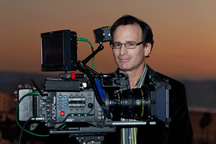
In filmmaking and video production, footage is raw, unedited material as originally filmed by a movie camera or recorded by a digital video camera, which typically must be edited to create a motion picture, video clip, television show, or similar completed work.[ not in body ]
Contents
- History
- Types of footage
- Film footage
- Television footage
- Amateur video footage
- Stock footage
- Footage broker
- See also
- References
- External links
Footage can also refer to sequences used in film and video editing, such as special effects and archive material (for special cases of this, see stock footage and B roll).[ not in body ]
Since the term originates in film, footage is only used for recorded images, such as film stock, videotapes, or digitized clips. For live television feeds, the signals from video cameras are instead called sources.[ not in body ]
